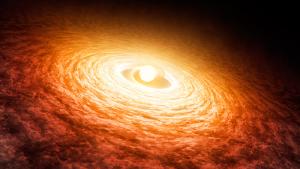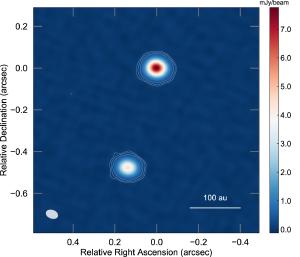Blog
Two to Tango
24 February 2020
 NASA/JPL-Caltech
NASA/JPL-CaltechBinary star systems are quite common in the universe, but we are still learning about how they form. Take for example the binary star FU Orionis. When it was discovered, it seemed to be just another faint star in the constellation Orion. But in 1937 it brightened significantly, from a magnitude 16 star to magnitude 9. It wasn’t clear how a star could change brightness so dramatically.
 ALMA/Pérez, Sebastián, et al.
ALMA/Pérez, Sebastián, et al.The most popular model for this change is that the young star as an accretion disk, and it brightened when more of the surrounding material was captured by the star. The problem with this idea is that most young stars have accretion disks. While a few stars are seen to quickly brighten in this way, most stars don’t. So what could trigger a sudden shift in the accretion rate of a star?
The answer could be that FU Orionis is binary. Recently a team used the ALMA observatory to image the disks surrounding the two stars.1 They found that each disk is asymmetrical, indicating that the two disks interact gravitationally. As the two stars orbit each other, the disks would interact most strongly during their close approach, and this could cause an uptick in accretion rates.
There are several FU Orionis-type stars that have been seen to brighten, and many of them are known to be binary systems. The next step would be to examine these stars to see if there is a similar interaction between their accretion disks.
Pérez, Sebastián, et al. “Resolving the FU Orionis System with ALMA: Interacting Twin Disks?.” The Astrophysical Journal 889.1 (2020): 59. ↩︎